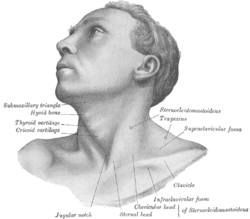Origin of speech
| Larynx | |
|---|---|

Anatomy of the larynx, anterolateral view
|
|
|
Anatomical terminology
[]
|
| Hyoid bone | |
|---|---|

Hyoid bone — anterior surface, enlarged
|
|

Anterolateral view of head and neck
|
|
| Details | |
| Precursor | 2nd and 3rd branchial arch |
| Identifiers | |
| Latin | os hyoideum |
| MeSH | A02.835.232.409 |
| Code | TA: A02.1.16.001 |
| FMA | 52749 |
|
Anatomical terms of bone
[]
|
|
| Hypoglossal nerve | |
|---|---|

Hypoglossal nerve, cervical plexus, and their branches
|
|
| Details | |
| Latin | nervus hypoglossus |
|
Anatomical terms of neuroanatomy
[]
|
|
| IPA vowel chart | |||||||||||||||||||
|---|---|---|---|---|---|---|---|---|---|---|---|---|---|---|---|---|---|---|---|
|
|||||||||||||||||||
| Paired vowels are: unrounded • rounded | |||||||||||||||||||
| This table contains phonetic symbols, which may not display correctly in some browsers. [Help] | |||||||||||||||||||
|
IPA help • IPA key • chart • |
|||||||||||||||||||
The origin of speech in Homo sapiens is a widely debated and controversial topic. The problems relate to humans' unprecedented use of the tongue, lips and vocal organs as instruments of communication. Other animals vocalise, but do not use the tongue to modulate sounds.
Although related to the more general problem of the origin of language, the evolution of distinctively human speech capacities has become a distinct and in many ways separate area of scientific research. The topic is a separate one because language is not necessarily spoken: it can equally be written or signed. Speech is in this sense optional, although it is the default modality for language.
Uncontroversially, monkeys, apes and humans, like many other animals, have evolved specialised mechanisms for producing sound for purposes of social communication. On the other hand, no monkey or ape uses its tongue for such purposes. Our species' unprecedented use of the tongue, lips and other moveable parts seems to place speech in a quite separate category, making its evolutionary emergence an intriguing theoretical challenge in the eyes of many scholars.
The term modality means the chosen representational format for encoding and transmitting information. A striking feature of language is that it is modality-independent. Should an impaired child be prevented from hearing or producing sound, its innate capacity to master a language may equally find expression in signing. Sign languages of the deaf are independently invented and have all the major properties of spoken language except for the modality of transmission. From this it appears that the language centres of the human brain must have evolved to function optimally irrespective of the selected modality.
"The detachment from modality-specific inputs may represent a substantial change in neural organization, one that affects not only imitation but also communication; only humans can lose one modality (e.g. hearing) and make up for this deficit by communicating with complete competence in a different modality (i.e. signing)."
This feature is extraordinary. Animal communication systems routinely combine visible with audible properties and effects, but not one is modality-independent. No vocally impaired whale, dolphin or songbird, for example, could express its song repertoire equally in visual display. Indeed, in the case of animal communication, message and modality are not capable of being disentangled. Whatever message is being conveyed stems from intrinsic properties of the signal.
...
Wikipedia

